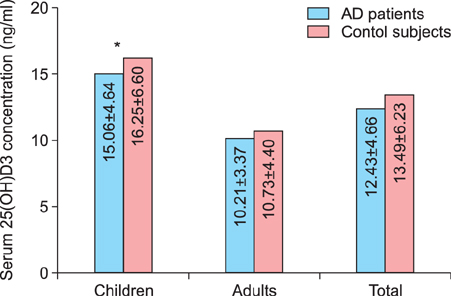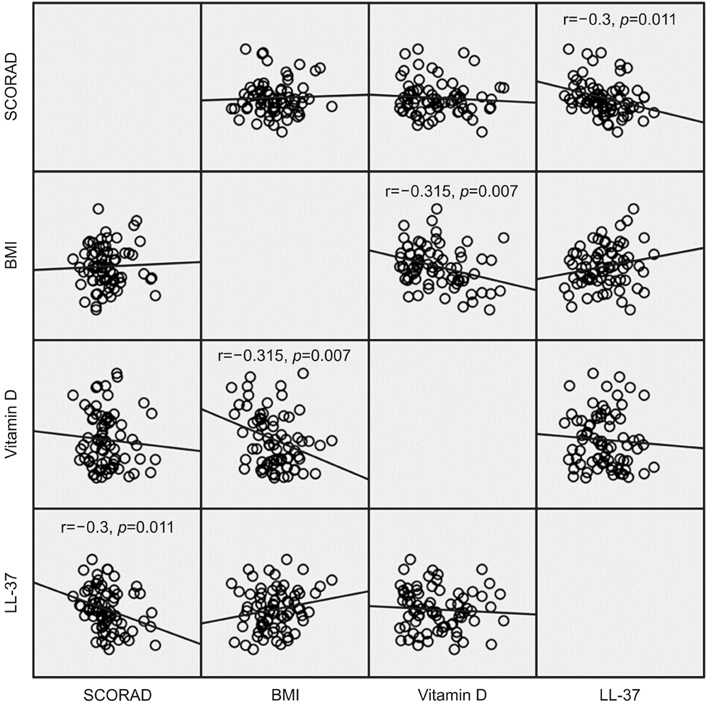Ann Dermatol.
2015 Feb;27(1):10-14. 10.5021/ad.2015.27.1.10.
Vitamin D Status and Its Association with the SCORAD Score and Serum LL-37 Level in Korean Adults and Children with Atopic Dermatitis
- Affiliations
-
- 1Department of Dermatology, Eulji General Hospital, Eulji University College of Medicine, Seoul, Korea. dermahan@gmail.com
- 2Eulji Medi-Bio Research Institute, Eulji University, Seoul, Korea.
- 3Division of Biotechnology, College of Life Science and Biotechnology, Korea University, Seoul, Korea.
- 4Department of Laboratory Medicine, Eulji General Hospital, Eulji University College of Medicine, Seoul, Korea.
- KMID: 2264830
- DOI: http://doi.org/10.5021/ad.2015.27.1.10
Abstract
- BACKGROUND
Vitamin D insufficiency could be associated with the prevalence of atopic dermatitis (AD).
OBJECTIVE
To examine vitamin D status and the relations between serum 25-hydroxyvitamin D levels, SCORAD score, serum LL-37 level, and body mass index (BMI) in Korean AD patients, and to explore whether these associations differ between adults and children.
METHODS
Serum 25-hydroxyvitamin D levels, serum LL-37, and clinical features were analyzed in a total of 72 Korean patients with AD (39 adults and 33 children) and 140 healthy control subjects (70 adults and 70 children).
RESULTS
Serum 25-hydroxyvitamin D levels were significantly reduced in children with AD (15.06+/-4.64 ng/ml) compared with normal children in the control group (16.25+/-6.60 ng/ml) (p=0.036). Significant inverse correlations were found between BMI and 25-hydroxyvitamin D level (r=-0.315, p=0.007) and between the SCORAD score and serum LL-37 level (r=-0.3, p=0.011) in the total AD patients.
CONCLUSION
The results showed that serum vitamin D levels were lower in children with AD than in healthy children; however, the same relation was not observed between adults with AD and healthy adults. Serum 25-hydroxyvitamin D concentration was not significantly correlated with AD severity or serum LL-37 levels in our study population.
Keyword
Figure
Cited by 2 articles
-
Protective Effect of Topical Vitamin D3 against Photocarcinogenesis in a Murine Model
Ji Seok Kim, Minyoung Jung, Jiyeon Yoo, Eung Ho Choi, Byung Cheol Park, Myung Hwa Kim, Seung Phil Hong
Ann Dermatol. 2016;28(3):304-313. doi: 10.5021/ad.2016.28.3.304.House Dust Mite Sensitization Is Inversely Associated with Plasma 25-Hydroxyvitamin D3 Levels in Patients with Severe Atopic Dermatitis
Yong Hyun Jang, Hyun Bo Sim, Sun Young Moon, Weon Ju Lee, Seok-Jong Lee, Meiling Jin, Sang-Hyun Kim, Do Won Kim
Ann Dermatol. 2017;29(4):400-406. doi: 10.5021/ad.2017.29.4.400.
Reference
-
1. Benson AA, Toh JA, Vernon N, Jariwala SP. The role of vitamin D in the immunopathogenesis of allergic skin diseases. Allergy. 2012; 67:296–301.
Article2. Holick MF. Vitamin D deficiency. N Engl J Med. 2007; 357:266–281.
Article3. Paul G, Brehm JM, Alcorn JF, Holguín F, Aujla SJ, Celedón JC. Vitamin D and asthma. Am J Respir Crit Care Med. 2012; 185:124–132.
Article4. Wang TT, Nestel FP, Bourdeau V, Nagai Y, Wang Q, Liao J, et al. Cutting edge: 1,25-dihydroxyvitamin D3 is a direct inducer of antimicrobial peptide gene expression. J Immunol. 2004; 173:2909–2912.
Article5. Gurlek A, Pittelkow MR, Kumar R. Modulation of growth factor/cytokine synthesis and signaling by 1alpha,25-dihydroxyvitamin D(3): implications in cell growth and differentiation. Endocr Rev. 2002; 23:763–786.
Article6. Ong PY, Ohtake T, Brandt C, Strickland I, Boguniewicz M, Ganz T, et al. Endogenous antimicrobial peptides and skin infections in atopic dermatitis. N Engl J Med. 2002; 347:1151–1160.
Article7. Chiu YE, Havens PL, Siegel DH, Ali O, Wang T, Holland KE, et al. Serum 25-hydroxyvitamin D concentration does not correlate with atopic dermatitis severity. J Am Acad Dermatol. 2013; 69:40–46.
Article8. Samochocki Z, Bogaczewicz J, Jeziorkowska R, Sysa-Jędrzejowska A, Glińska O, Karczmarewicz E, et al. Vitamin D effects in atopic dermatitis. J Am Acad Dermatol. 2013; 69:238–244.
Article9. Peroni DG, Piacentini GL, Cametti E, Chinellato I, Boner AL. Correlation between serum 25-hydroxyvitamin D levels and severity of atopic dermatitis in children. Br J Dermatol. 2011; 164:1078–1082.
Article10. Kanda N, Hau CS, Tada Y, Sato S, Watanabe S. Decreased serum LL-37 and vitamin D3 levels in atopic dermatitis: relationship between IL-31 and oncostatin M. Allergy. 2012; 67:804–812.
Article11. Oranje AP, Glazenburg EJ, Wolkerstorfer A, de Waard-van der Spek FB. Practical issues on interpretation of scoring atopic dermatitis: the SCORAD index, objective SCORAD and the three-item severity score. Br J Dermatol. 2007; 157:645–648.
Article12. Hyppönen E, Sovio U, Wjst M, Patel S, Pekkanen J, Hartikainen AL, et al. Infant vitamin d supplementation and allergic conditions in adulthood: northern Finland birth cohort 1966. Ann N Y Acad Sci. 2004; 1037:84–95.
Article13. Brehm JM, Schuemann B, Fuhlbrigge AL, Hollis BW, Strunk RC, Zeiger RS, et al. Serum vitamin D levels and severe asthma exacerbations in the Childhood Asthma Management Program study. J Allergy Clin Immunol. 2010; 126:52–58.e5.
Article14. Brehm JM, Celedón JC, Soto-Quiros ME, Avila L, Hunninghake GM, Forno E, et al. Serum vitamin D levels and markers of severity of childhood asthma in Costa Rica. Am J Respir Crit Care Med. 2009; 179:765–771.
Article15. Chinellato I, Piazza M, Sandri M, Peroni D, Piacentini G, Boner AL. Vitamin D serum levels and markers of asthma control in Italian children. J Pediatr. 2011; 158:437–441.
Article16. Goleva E, Searing DA, Jackson LP, Richers BN, Leung DY. Steroid requirements and immune associations with vitamin D are stronger in children than adults with asthma. J Allergy Clin Immunol. 2012; 129:1243–1251.
Article17. Kim SH, Oh MK, Namgung R, Park MJ. Prevalence of 25-hydroxyvitamin D deficiency in Korean adolescents: association with age, season and parental vitamin D status. Public Health Nutr. 2014; 17:122–130.
Article18. Lee YA, Kim HY, Hong H, Kim JY, Kwon HJ, Shin CH, et al. Risk factors for low vitamin D status in Korean adolescents: the Korea National Health and Nutrition Examination Survey (KNHANES) 2008-2009. Public Health Nutr. 2014; 17:764–771.
Article19. Choi EY. 25(OH)D status and demographic and lifestyle determinants of 25(OH)D among Korean adults. Asia Pac J Clin Nutr. 2012; 21:526–535.20. Mithal A, Wahl DA, Bonjour JP, Burckhardt P, Dawson-Hughes B, Eisman JA, et al. CSA) Nutrition Working Group. Global vitamin D status and determinants of hypovitaminosis D. Osteoporos Int. 2009; 20:1807–1820.
Article21. Howell MD, Wollenberg A, Gallo RL, Flaig M, Streib JE, Wong C, et al. Cathelicidin deficiency predisposes to eczema herpeticum. J Allergy Clin Immunol. 2006; 117:836–841.
Article22. Hata TR, Kotol P, Jackson M, Nguyen M, Paik A, Udall D, et al. Administration of oral vitamin D induces cathelicidin production in atopic individuals. J Allergy Clin Immunol. 2008; 122:829–831.
Article23. Gallo RL, Murakami M, Ohtake T, Zaiou M. Biology and clinical relevance of naturally occurring antimicrobial peptides. J Allergy Clin Immunol. 2002; 110:823–831.
Article24. Leung TF, Ching KW, Kong AP, Wong GW, Chan JC, Hon KL. Circulating LL-37 is a biomarker for eczema severity in children. J Eur Acad Dermatol Venereol. 2012; 26:518–522.
Article25. Frost M, Abrahamsen B, Nielsen TL, Hagen C, Andersen M, Brixen K. Vitamin D status and PTH in young men: a cross-sectional study on associations with bone mineral density, body composition and glucose metabolism. Clin Endocrinol (Oxf). 2010; 73:573–580.
Article26. Arunabh S, Pollack S, Yeh J, Aloia JF. Body fat content and 25-hydroxyvitamin D levels in healthy women. J Clin Endocrinol Metab. 2003; 88:157–161.
Article27. Florez H, Martinez R, Chacra W, Strickman-Stein N, Levis S. Outdoor exercise reduces the risk of hypovitaminosis D in the obese. J Steroid Biochem Mol Biol. 2007; 103:679–681.
Article28. Wortsman J, Matsuoka LY, Chen TC, Lu Z, Holick MF. Decreased bioavailability of vitamin D in obesity. Am J Clin Nutr. 2000; 72:690–693.
Article29. Amestejani M, Salehi BS, Vasigh M, Sobhkhiz A, Karami M, Alinia H, et al. Vitamin D supplementation in the treatment of atopic dermatitis: a clinical trial study. J Drugs Dermatol. 2012; 11:327–330.30. Hata TR, Audish D, Kotol P, Coda A, Kabigting F, Miller J, et al. A randomized controlled double-blind investigation of the effects of vitamin D dietary supplementation in subjects with atopic dermatitis. J Eur Acad Dermatol Venereol. 2014; 28:781–789.
Article
- Full Text Links
- Actions
-
Cited
- CITED
-
- Close
- Share
- Similar articles
-
- Correlation between serum 25-hydroxyvitamin D levels and severity of atopic dermatitis in children
- Correlation between the Level of Urinary Leukotriene E4 and Seurm Eosinophil Cationic Protein and Clinical Severity of Atopic Dermatitis in Children
- Correlation between Severity of Atopic Dermatitis and Sleep Quality in Children and Adults
- Relationship between serum interleukin-31/25-hydroxyvitamin D levels and the severity of atopic dermatitis in children
- Effects of Outdoor Activities in Forests on Atopic Dermatitis



